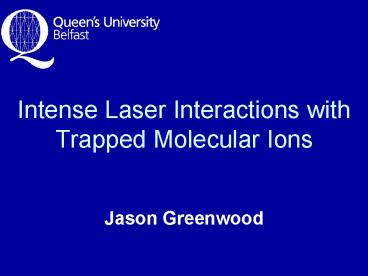Intense Laser Interactions with Trapped Molecular Ions - PowerPoint PPT Presentation
1 / 32
Title:
Intense Laser Interactions with Trapped Molecular Ions
Description:
Intense Laser Interactions with Trapped Molecular Ions. Jason Greenwood. Dissociation of H2 in an Intense Laser Field ... Intense Field Dressed States ... – PowerPoint PPT presentation
Number of Views:52
Avg rating:3.0/5.0
Title: Intense Laser Interactions with Trapped Molecular Ions
1
Intense Laser Interactions with Trapped Molecular
Ions
- Jason Greenwood
2
Outline
- Dissociation of H2 in an Intense Laser Field
- Electrostatic Ion Cavity
- Stability and loss
- Preliminary results of D2, HD dissociation
- Manipulating trapped ions
- Planned Experiments
- ASTRA laser
- Future
3
Photon Induced Dissociation of H2
- TiSapphire laser pulse
- 800 nm
- 1.55 eV
- 2.5 fs period
- Two states
- 1s?g (ground)
- 2p?u
- H2(?9) 1? (800nm) ? H H 0.77eV
www.mpq.mpg.de/haensch/h2/introduction.htm
4
Intense Field Dressed States
- System represented by superposition of states
dressed by large number of photons, separated by
1? - Diabatic Curves
5
Avoided Crossings
- Coupling between statesproduces avoided crossing
- Coupling E field dependent
- Vibrational period ? 15 fs
- Adiabatic dressed states
- long pulses ? gtgt 15 fs
- avoided crossing at 1? or 3?
6
H2 Dissociation
- Field induces electric dipolealong internuclear
axis - Bond Softening
- nett 1 photon absorptionfor ? ? 5
- nett 2 photon absorptionfor ?? 4
7
Experimental Studies
- Neutral Target
- H2 laser ? H H non-sequential ionization
- ? H2(?) laser ? H H0 dissociation
? H H ionization (SI, EI) - Ion Target
- H2 e? ? H2(?) laser ? H H0
dissociation ? H H ionization (SI,
EI) - Advantages of ion target
- first ionization process unrelated to laser
interaction - fast products, hence H0 detectable (pure
dissociation)
8
H2 Vibrational Distibutions
e- impact
3 x 1013 W cm-2
- Posthumus et al., PRL, 92, 163004 (2004)
4.8 x 1013 W cm-2
1.5 x 1014 W cm-2
9
Theory vs Experiment
- Comparison difficult due to strong dependence on
- Vibrational population
- Intensity (varies spatially, temporally)
- Experimental energy resolution
1? vib. release (dashed)
2? vib. release (dotted)
Numerical solution of time dependent Schrödinger
equation for 2 state model for H2 with
Franck-Condon vibrational population.
L-Y Peng et al. J. Phys. B 38, 1727 (2005)
10
H neutrals from H2 50fs pulses Ian
Williams(QUB), Roy Newell(UCL) et al.
11
Transition to Ultra-short Pulses
- ? ? 15 fs inclusion of quantum nuclear motion
important - Dramatic change from adiabatic dissociation (long
pulse) to frozen nuclei (short pulse) - To verify theoretical predictions experiment
needs well defined vibrational states!
H2 (? 0) Dissociation
5 fs
10 fs
20 fs
L-Y Peng et al. J. Phys. B 38, 1727 (2005)
12
Why Trap Ions?
- Extended period for ion manipulation
- Internal pumping, de-excitation
- External manipulation of ion phase space
- Extended period of measurement
- Metrology, mass spectrometry
- Lifetime measurements
13
Linear Electrostatic Trap (Ion Cavity)
- Ion Cavity (Dahan et al., Rev. Sci. Instrum., 69,
76 (1997) - For ions, refractive index ? V1/2
- Symmetric Laser cavity stable when
R 2f
L
14
QUB Trap
- 2 planar mirrors, 2 lenses
- Trapped filled by pulsing entrance mirror
- Features
- Electrostatic, trapping mass independent
- keV ions stored, fast neutrals detected
- ToF measurements possible due to linear motion of
ions
15
Potential Energy Surface
16
Ion Loss Mechanisms
- Population of Unstable Trajectories
- most ions lost by 1 ms
- Neutralisation in background gas
- X A ? X0 A
- X? A ? X0 A e-
- cross section can vary for excited states giving
multi-component decay - Elastic scattering in background gas
- Ion lost if scattered outside region of stable
phase space - May undergo multiple collisions
- Ion-ion scattering
- Density dependent
- Most significant at early trapping times
- External Perturbations
- Ions pushed outside stable phase space
17
H2
18
(No Transcript)
19
Dissociation Analysis by ToF
- Detect neutral D fragments
- 2 ToF peaks
20
Laser Intensity lt 1011 Wcm-2
21
Producing HD (? 0)
- Passive Cooling
- use HD with dipole moment
- ? 1 to ? 0 lifetime 80 ms
- gt 95 ? 0 after 300 ms
Vibrational decay of HD from initial
Franck-Condon distribution
22
(No Transcript)
23
(No Transcript)
24
Ion Velocity Cooling
- Routinely performed at MeV, GeV energies
- Not directly demonstrated at keV energies
- Results in improved ToF resolution
25
V
V
V
t
?E
??E
V
V
26
Manipulation of Ion Phase Space
27
Ion Cooling
Al? Si?
28
(No Transcript)
29
(No Transcript)
30
Summary of Progress
- Positive and negative ions trapped for seconds
- Molecular dissociation energy release measured
for different trapping times - Ion cooling / bunch stabilisation demonstrated
- Energy spread reduced from 16 eV to 8 eV
31
Potential Applications
- High resolution ToF studies of internally and
externally cold molecular ions, e.g. HD, CH,
CO - ASTRA Run June,July 2006
- HD (? 0) passive cooling 300 ms
- Dissociation using 30 fs and 10 fs pulses
- Future ASTRA work with CEP stabilised ultrashort
pulses. Control of - HD (? 0) ? H D
- HD (? 0) ? H D
- Potential for studies of biomolecular
fragmentation
32
Acknowledgements
- CCLRC, EPSRC
- EU Framework 6 Integrated Infrastructure
Initiative - Ion trapping
- Higher Education Authority (Rep. of Ireland)
- Plasma and Ion Beam Network (Dublin City
University/QUB)
Ian Williams Jarlath McKenna Jofre
Pedregosa-Gutierrez Philip Orr John
Alexander Wesley Walter (Denison University, Ohio)































